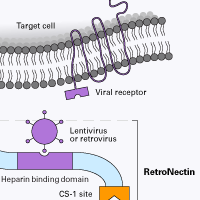RetroNectin detection
RetroNectin is a recombinant human fibronectin (CH-296) that consists of three functional domains: the human fibronectin cell-binding domain (C-domain), heparin-binding domain (H-domain), and CS-1 sequence domain. RetroNectin-containing recombinant retroviral vector is often used to improve transduction efficiency during mammalian cell gene transfer. This occurs because the RetroNectin molecule enables close proximity between the H-domain-binding retroviral vector and the transduced animal cell, which has a strong affinity for the RetroNectin C-domain. Additionally, RetroNectin is an effective coating matrix for instruments and labware used to expand ex vivo lymphocytes.
RetroNectin is a recombinant human fibronectin (CH-296) that consists of three functional domains: the human fibronectin cell-binding domain (C-domain), heparin-binding domain (H-domain), and CS-1 sequence domain. RetroNectin-containing recombinant retroviral vector is often used to improve transduction efficiency during mammalian cell gene transfer. This occurs because the RetroNectin molecule enables close proximity between the H-domain-binding retroviral vector and the transduced animal cell, which has a strong affinity for the RetroNectin C-domain. Additionally, RetroNectin is an effective coating matrix for instruments and labware used to expand ex vivo lymphocytes.
The RetroNectin EIA Kit is a sandwich RetroNectin ELISA that takes advantage of plate-coated RetroNectin-specific monoclonal capture antibody to detect and quantitate RetroNectin. The RetroNectin EIA Kit does not cross-react with human fibronectin. Furthermore, RetroNectin monoclonal antibody cross-reactivity is not inhibited even in the presence of human blood components, enabling easy determination of RetroNectin levels. This RetroNectin ELISA also allows highly sensitive quantitation of RetroNectin in cell cryopreservation solutions as well as in cell culture fluids and washes.
More Information
Applications
- Quantitation of RetroNectin in cryopreservation solutions, cell culture fluids, and washes
- Sensitive detection of as little as 3.1 ng/ml of RetroNectin
Performance
- Range of assay: 3.1–200 ng/ml
- Sensitivity: 3.1 ng/ml
- Assay duration: 2.5 hours
- Specificity: RetroNectin
- Test specimen type: Cryopreservation solutions, cell culture fluids, and washes.
- Specimen volume required: 100 µl
Product citations
Donahue, R.E. et al. Fibronectin fragment CH-296 inhibits apoptosis and enhances ex vivo gene transfer by murine retrovirus and human lentivirus vectors independent of viral tropism in nonhuman primate CD34+ cells. Mol. Ther. 3, 359–367 (2001).
Additional product information
Please see the product's Certificate of Analysis for information about storage conditions, product components, and technical specifications. Please see the Kit Components List to determine kit components. Certificates of Analysis and Kit Components Lists are located under the Documents tab.
Takara Bio USA, Inc.
United States/Canada: +1.800.662.2566 • Asia Pacific: +1.650.919.7300 • Europe: +33.(0)1.3904.6880 • Japan: +81.(0)77.565.6999
FOR RESEARCH USE ONLY. NOT FOR USE IN DIAGNOSTIC PROCEDURES. © 2025 Takara Bio Inc. All Rights Reserved. All trademarks are the property of Takara Bio Inc. or its affiliate(s) in the U.S. and/or other countries or their respective owners. Certain trademarks may not be registered in all jurisdictions. Additional product, intellectual property, and restricted use information is available at takarabio.com.




